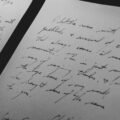The world’s oldest drawing of a ghost has been discovered among collections held at the British Museum in London.
While visiting the museum’s vaults in recent days, a researcher says he came across a 3500-year-old Babylonian clay tablet that depicted a forsaken, bearded spirit bound and being led to the afterlife by his lover.
The lines are faint, and only visible when held at a certain angle and under good light. Yet this spectacular discovery is believed to depict an ancient tutorial on how to banish unwanted spirits from the land of the living.
This, in other words, might be the world’s oldest ghost story… and it arrives just in time for Halloween.
Background: The myths of Babylon
The stories surrounding Babylon and its myths have stimulated the imagination of many throughout the years, inspiring writers, philosophers, and all types of artists. One of the most famous cities of antique Mesopotamia, Babylon was of great political, commercial, literary, and religious importance.
A vast number of artifacts from that time have been collected, thoroughly studied, and kept safe in places like the British Museum. In fact, if you search for “Babylon” on their website, you’ll find over 14 thousand artifacts in their collection, including tablets, amulets, projectile points, and many other utensils and trinkets.
While taking another look at the Babylonian collection, Dr. Irving Finkel, curator of the Middle Eastern department at the British Museum, was faced with a piece that he’s never seen before. As he said, this tablet, an “absolutely spectacular object from antiquity” had been overlooked until now.


Analysis: How to get rid of a 3500-year-old ghost?
“It’s obviously a male ghost and he’s miserable. You can imagine a tall, thin, bearded ghost hanging about the house did get on people’s nerves. The final analysis was that what this ghost needed was a lover”, he said according to a report by The Guardian.
Half of the tablet is missing and it is quite small, enough to fit on someone’s hand. On the front, you see the ghost of a man with his arms outstretched and wrists tied by a rope that’s being carried by a female. The back contains an extensive and detailed guide on how to deal with a ghost who came back to the world of the living to find some needed companionship.
As a figure of authority when it comes to cuneiform script, Finkel claims that the tablet was never correctly deciphered. He believes that it is a part of an exorcism’s guide to getting rid of ghosts by addressing the cause that brought them back to the world of the living. In this case, the ghost supposedly came back because it needed a lover. Dr. Finkel jests: “That somebody thinks they can get rid of a ghost by giving them a bedfellow is quite comic”.
The instructions given by the text are very clear and they include creating figurines, clothing, using specific objects, plants, and even the time at which the ritual should be performed. The text ends with a warning: “Do not look behind you!”.
Outlook: Babylonian history revisited
Because of its condition, this tablet has been misinterpreted for years. It has been in the British museum since the 19th century and has never been publicly displayed. But Finkel hopes to change that in the future.
Not only is he featuring his discoveries in his upcoming book, “The First Ghosts: Most Ancient of Legacies”, to be published on 11 November by Hodder & Stoughton, but he also hopes to exhibit the Babylonian tablet as he believes it brings us closer to our ancestors: “All the fears and weaknesses and characteristics that make the human race so fascinating, assuredly were there in spades 3,500 years ago”.
“I want people to know about this culture”, he concludes.
Raquel is a forensic geneticist turned freelance writer. She has a knack for technology and a passion for science. You can follow her at scitechcorner.com and on Twitter @theRaquelSantos.
